President's Message
2011 has been an exciting year commemorating Henrico County's 400th anniversary. It has been my pleasure to serve on the 2011 Commemoration Advisory Commission on behalf of the Henrico County Historical Society. The Commission was divided into subcommittees for event planning throughout the year, each representing a chapter in Henrico history.
A special website was created to promote Henrico and the 400th anniversary events held throughout the year. A speaker's bureau was established to provide organizations and civic groups information on Henrico history.
In January, Hunt for Henrico History was held to encourage citizens to bring their collections or family histories to be recorded. African American history was presented in February. In March the Kite Festival and Tastes and Sounds of Henrico were featured at Dorey Park. Also in March, a Virginia Indian Cultural Program was held at the Cultural Arts Center at Glen Allen. All Henrico Reads, featuring David Baldacci, was held in April. Earth Day, also in April, was limited because of inclement weather conditions, but information was provided at Three Lakes Park. Moving Henrico Forward: Air, Road, Rail, and Water was held at the Virginia Aviation Museum in May. A Fourth of July celebration was held at Meadow Farm. In September, there was a three day Civil War commemoration held at the Henrico Theatre, Tree Hill Farm, and Fort Harrison.
There was also a reenactment of the wedding of Pocahontas and John Rolfe at Dorey Park hosted by the Varina Women's Club.
The Harvest Festival was held at Meadow Farm and another Hunt for Henrico History event held at the new Eastern Recreation Center, which opened to great fanfare in October.
In partnership with the Valentine Richmond History Center, a series of bus tours featured Henrico history, and the Valentine Richmond History Center will also feature a photo gallery of Henrico images on November 26th.
The Lakeside Farmers Market hosted a Henrico birthday party, and a program was held at Lewis Ginter Botanical Park. There were Henrico 400th events at the Diamond with the Flying Squirrels and at Richmond International Raceway.
Many legacy projects were established this year, including the Notable Henricoans Database created and maintained by Henrico County Libraries, the Henrico Advantage Card to encourage local shopping, and the Historcal Data book which includes everything you would want to know about Henrico. It is linked to the Henrico County website.
Henrico County schools compiled the history of each public school and had historic plaques issued to the oldest. Henrico County Schools also created a History of Henrico DVD and added Henrico County history to its curriculum. They had sycamore trees planted at each school in remembrance of Miss Virginia Randolph. There was a dedication and reopening of the Virginia Randolph Museum under the direction of the Division of Recreation and Parks.
The Welcome to Henrico 400 signs and Dabbs House Visitors Center signs on I-64 extend greetings to visitors of our county, as does a new Henrico County brochure. Henrico now has an official song written especially for its 400th anniversary, and we will soon have a book updating the history of the County.
The Henrico County Historical Society promoted events held in the 10 counties that were originally part of the Henrico Shire. We hope you will join us for the HCHS sponsored event on December 4, and for the event sponsored by the Fluvanna Historical Society on Saturday, December 10, an Old Fashioned Village Holiday in the Village of Palmyra.
And last, we will have a time capsule of 2011 to be opened in 50 years so that those of the future will know of Henrico's 400th anniversary. It will be located at the Government Administartion Building.
Many thanks to all of the volunteers, Henrico staff, and participating organizations who made all of these events possible and to all of you for your interest in Henrico history.
Sarah Pace,
President
>Back to Top<
Gayle Davis
The Henrico County Historical Society expresses its deepest sympathy to the family of Gayle Davis. Gayle served previously as the 2nd Vice President of HCHS.
>Back to Top<
A Reminder about HCHS Yearly Dues
Please kindly note that HCHS yearly membership dues are now renewed in January. Thank you.
>Back to Top<
HCHS Calender 2012
Order your 2012 HCHS Calendar now. It features 12 aspects of the Civil War in Henrico County, including the first artillery on rails; distinguished African-American soldiers, reconnaissance by balloon; homefront activities; Jewish heroes, and much more.
Each calendar is $12.00 plus tax and shipping. Call 804-839-2407 to place your order.
An excellent suggestion for a holiday gift!
>Back to Top<
September Meeting Highlights

The Civil War Surgeon was the discussion of Dr. Steven J. Schmidt, who was the featured speaker at our September HCHS quarterly meeting.
The sanctuary of Ridge Baptist Church might seem a rather odd venue for a discussion of the sometimes gruesome Civil War surgical practices. However, since the original nineteenth century church building, now gone, served as a hospital during the the war, it was actually quite a fitting site for the September HCHS meeting where Dr. Steven J. Schmidt lectured on the medical conditions and procedures of Civil War surgery and shared his extensive collection of surgical implements with the membership. Samples of his collection included the following:

Left: A capital set of surgical instruments used in battlefield surgery.
Below:
Left picture: A fleam used for bloodletting.
Center picture: Suturing silk and needles.
Right picture: Prostheses for amputees. The bottom example has a small shelf which would have supported the soldier who apparently lost his leg just above the ankle.
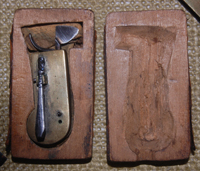
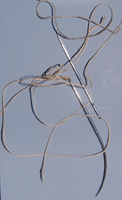
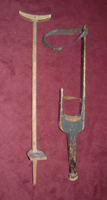
>Back to Top<
Reclaiming the Randolph Family Cemetery
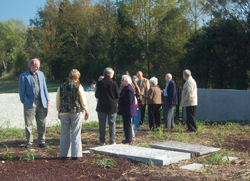
It was off to Turkey Island for the October meeting of the Association for the Preservation of Henrico Antiquities, where members got to see the results of a significant APHA project.
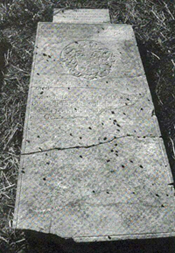
The Turkey Island burial ground was the family cemetery for the eminent Randolph family of Virginia. Colonel William Randolph's grave can be seen on the left, and at the bottom left are more recent markers for him and his wife, Mary Isham Randolph. (The large grave markers for the two can be seen in the bottom-most photograph). However, neglect and hurricanes had taken a toll on the site, and the APHA enlisted the help of Larry Cluff, a contractor specializing in historic preservation, to help restore it.
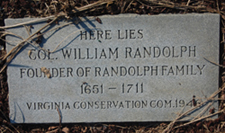
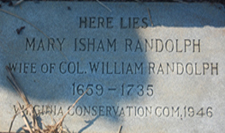
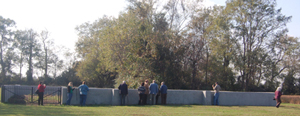
Wildly overgrown pokeberry bushes, which APHA President Henry Nelson said allowed you to see about an arm's length into the cemetery, were cleared, and a permanent mulch was put down. The surrounding wall was straightened and coated; and gates (one of which can be seen in the photograph above taken outside the cemetery) were installed to allow access, previously gained by a long-gone stile.
>Back to Top<
Sycamores at the Virginia Randolph Museum
We continue to look for the oldest tree in Henrico County and for other trees with historical significance, innate beauty or magnificent size. Here are several trees whose significance, size and beauty qualify them for our attention.

On March 30, 1908, Virginia Estelle Randolph conducted the first Arbor Day Program in Virginia. On that day, she and her students planted twelve Sycamore trees, naming them for the twelve disciples. The original trees were named the first Notable Trees in Virginia. Some of the trees remain standing as living monuments, but over the years, some of the trees have been lost to disease. The photograph on the left shows a grove of replacement trees. The bottom left photo shows the oldest and largest of the trees, possibly an original. The bottom right photo shows a wider shot of the trees and at the left in the photo Miss Randolph's grave can be seen in the yard of the Virginia Randolph Museum on Mountain Road.
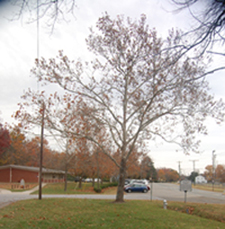
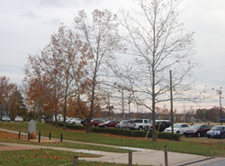
>Back to Top<
A Christmas Salute from the 1800s
Forty-four years later, recollection of a holiday encounter reconnects two men previously unaware of the connection.
The Virginia Historical Society has in its collection a document (Mxx5:IC3685:4) identified as "A recollection, written by John Taylor Chappell (1845-1915), concerning an event that occurred on 25 December 1864 involving a member of Parker's Artillery Battery and a northern civilian in a Union observation tower near Dutch Gap in Henrico County." Taylor himself entitled it "A Christmas Salute," and by way of introduction, he tells us that as an "entertainment given by the members of a beneficial organization in Richmond, Va. Jan 1897," people exchanged stories of the Civil War. All in attendance were Southerners with the exception of one Northerner who had not fought in the war and was, it seems, rather glad because, as he said, "in the first place my hands are clean, so far as the sheding [sic] of human blood is concerned."
Chappell writes:
Well, responded our "Yankie [sic] brother as well as I can remember, it happened on Christmas morning, I think, of '63 or it might have been '64 I am not certain, however, at the time Genl. B. F. Butler, called by you people the "Beast" was in command of the Army location on James River a few miles below this City and at a point known as "Dutch Gap" a good many of my friends were with Butler's command and on this particular Christmas I conceived the idea of paying them a friendly visit. So I ran down from my house in New England for this purpose along & not I assure you with blood in my eyes. I found Genl. Butler at the time engaged in the collossal [sic] undertaking of constructing a canal for the purpose of straightening the river at this point which, by the way, made a great sweeping bend here & returning left a narrow strip of land only to be removed in order to save miles of unnecessary travel. Well as you all know this work proved a great success, it has proven to be of great benefit to navigation and I do not find our Southern friends disposed to "boycot [sic] it" on account to its having been constructed by Benjamin "The Beast." All river boats now pass thro it and have done so ever since the war ended.
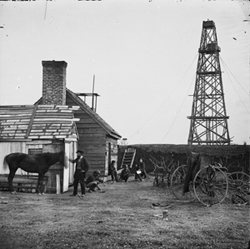
Now, in connection with the canal in question Butler had constructed, entirely of wood a very high tower or observatory, so high was it in fact that from its dizzy height a clear and unobstructed view was presented of the entire surrounding country and signal officers from its top kept Genl. Butler posted regarding the movements of you "Rebels" while he toiled away on the canal. The tower was located so far within the federal lines as to place it entirely beyond the range of the Southern guns and it was regarded as perfectly safe to make observations of the country from its top, I remember what I saw from it. Well now, I had never seen a Rebel and like all other New Englanders, I am endowed, or was then, with my full share of curiosity. Here was an opportunity for gratifying a morbid desire to behold one with out risking any feature of my sacred anatomy to the tender mercy of an Enfield rifle bullet. So after securing a permit to ascend the tower & after having armed my self with a pair of powerful field glasses, I slowly climbed to the top. The sight was a grand one. I found myself high above the hills and tree tops and a beautiful roling [sic] country spread itself out before me almost to the limit of sight on every side. I could see in the distance, when looking westward the white tents of the rebels behind a line of fortifications or earth works and I was really enjoying this magnificent scenery when all of a sudden a column of blue smoke arose some distance of and little to the left of the tower. I was not looking for this and turning my glasses in that direction was about to make an observation for the purpose of ascertaining the cause, while simultaneously with a dull boom something struck one corner of the structure and caused it to quiver from top to bottom while fragments flew out in every direction. "They have got the range cried out the signal officer," and with out a particle of cerimony [sic] he proceeded at once to descend and as fast as his hands & legs would allow. Because I followed without awaiting the formality of an invitation, it seemed to me at the time that I consumed at least thirty minutes in getting to the ground, but I finally got there and when I did I drew a long breath & thanked the good Lord for my deliverance. My curiosity had been satified. I had seen the rebels, at a distance to be sure but they were just as near as I wanted them & the next day early in the morning I packed my grip and started my return trip to the green hills and rocky cost [sic] of New England. Now gentlemen you are in possession of my entire war record.
"Wait a moment, I have just a word to say here that might prove interesting to you" said another gentlemen present. "It may seem somewhat of fiction but it is nevertheless true. I fired the shot that drove you off of Butler's tower, and I am going to tell you just how it all happened. "The tower at Dutch Gap was a constant source of annoyance to us. I was at that time a noncommissioned officer in Parker's Battery, stationed near the enemy's lines & in plain view of the tower in question and had charge of the guns. As has been correctly stated this tower was so far within the enemy's lines to be entirely beyond our range and having no powder to waste at useless target practice we were forced daily to witness signaling going on from its top with out power on our part to prevent it. Well, to bring this story to a close I will state that one Christmas ever a lot of the boys conceived the idea that we might at some little risk and under cover of darkness give the enemy a practical Christmas Salute and after making our arrangements we laid our plan before Capt. Parker and asked his permission to carry it out. The Capt. thought it all right and entered into the spirit of the scheme.
So on Christmas Eve night my gun crew stole close enough to be within range of Butler's tower and after having masked our guns we quietly waited for day break. We fully realized that we were engaged in a risky business and used every caution possible. When morning came the first thing I did was to train & aim that gun after doing so I allowed every man to sight it until all were satisified that the sighting could not be improved upon. Very early in the morning the tower seemed to be entirely deserted but a little later we saw two men making their way to the top adn we waited patiently for them to get busy. We knew full well that we could not fire but one shot before being forced to leave our position and we wanted to make the most of that one. Now boys, I said, we will now let them have it and after having again sited the gun I gave the command to fire & had the satisfaction of seeing the splinters fly from Butler's tower and its occupants hurriedly descending to the ground.
Dr. Parker often said that it was the best shot made by the battery during the War. Of course we made tracks as soon as we fired it.
The most singular part of this story is yet to be told. The active parties to it had been intimately associated for nearly twenty-five years being together two or three times a week during that time yet each was ignorant of the part the other took in it.
The Northern man referred to was Roland Hill a merchant of this City doing business on 18th Street. And the gunner who fired the shot is Mr. P. V. Sherer a merchant by trade and still living now a resident of Chesterfield Co Va.
Nov. 1908
>Back to Top<
Now You Know
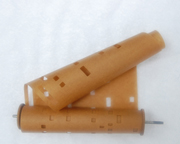
We had a number of respondents to our September "What Do You Know?" item, the roll of perforated paper wound on a wooden spindle pictured directly above. The most popular guess was that it was for a player piano, and that was close but not quite right.
The paper was actually for a roller organ. These nineteenth centry "music boxes" provided families who couldn't afford a piano or pump organ with a source of music.
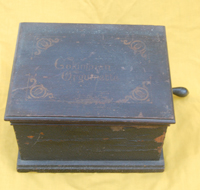
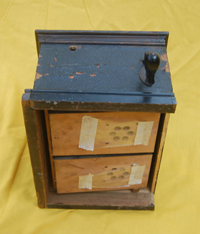
The various versions, two of which are featured here, worked through a bellows that create a vacuum that sucked air across reeds, thereby producing music.
You can find more information about these instruments at www.rollerorgans.com.
Columbian Orguinette
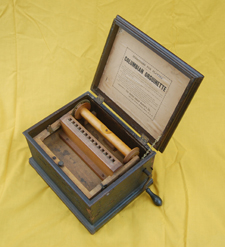
This roller organ, whose works are encased in a leather-covered wooden box, worked on a vacuum. The operator turned the crank on the right of the box. This simultaneously operated the bellows (seen in the small phtograph of the box's bottom) and drew the roll of perforated paper across the harmonica-like reed bank seen in the larger photograph directly above. As the opening in the paper passed over the reed hole, it allowed air to pass through and over the reed inside to produce a note. Rolls could contain several musical pieces, depending on the length of the roll. When the spool reached the end of the roll, a smaller crank was inserted, the spool was unlocked, and the paper rewound onto the spool.
Gem Roller Organ
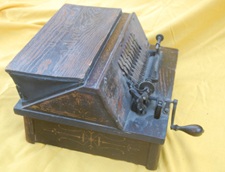
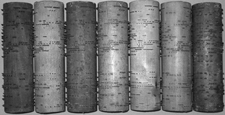
This organ's works are exposed. As the hand crank is turned, a bellows underneath the instrument is operated. The vacuum is passed to the reservoir, which uses the top of the case as the bellows. The crank also turns the cob, a spindle with small pins on it (right photograph). The pins caused the small lever with a leather-padded pallet to rock back and allow air to pass through the now-opened reed hole. The twenty reeds arranged in two banks allowed for relatively sophisticated music to be played.
>Back to Top<
What Do You Know?
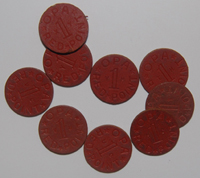
These red cardboard discs are one half inch in diameter and about one sixteenth of an inch thick.
Do you know what they are? Email your answer to: jboehling@verizon.net.
>Back to Top<
News 2011: Fourth Quarter
First Quarter | Second Quarter | Third Quarter
Home | Henrico | Maps | Genealogy | Preservation | Membership | Shopping | HCHS
|











